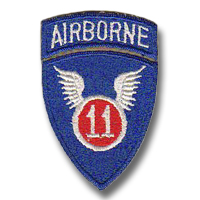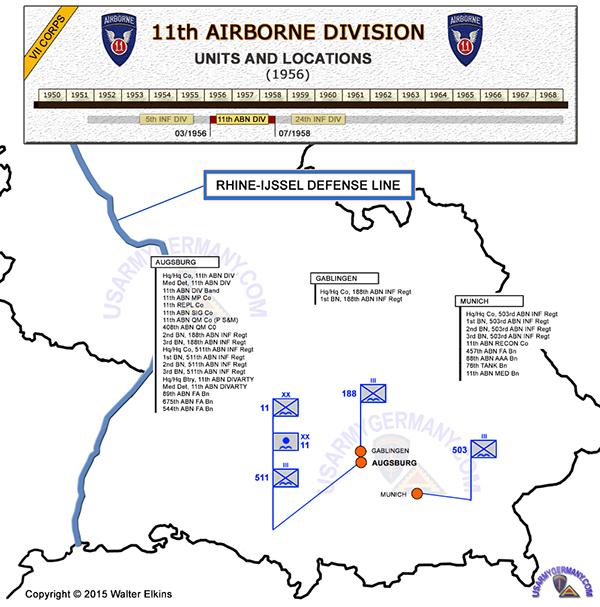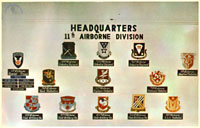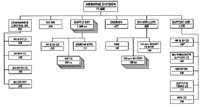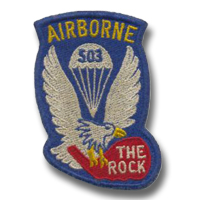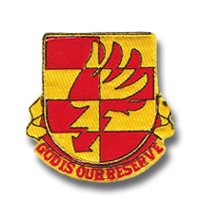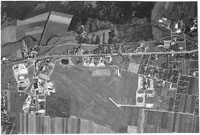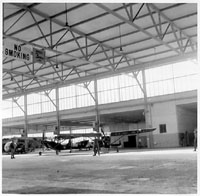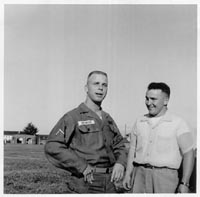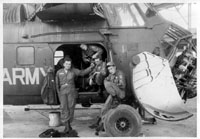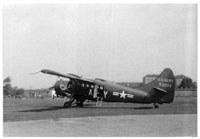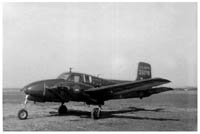| If you do NOT see the Table of Contents frame to the left of this page, then Click here to open 'USArmyGermany' frameset |
|||||||||||||||||||||||||||||||||||||||||||||||||||||||||||||||||||||||||||||||||||||||
|
11th
Airborne Division |
|||||||||||||||||||||||||||||||||||||||||||||||||||||||||||||||||||||||||||||||||||||||
|
|
|||||||||||||||||||||||||||||||||||||||||||||||||||||||||||||||||||||||||||||||||||||||
|
|||||||||||||||||||||||||||||||||||||||||||||||||||||||||||||||||||||||||||||||||||||||
|
|
|||||||||||||||||||||||||||||||||||||||||||||||||||||||||||||||||||||||||||||||||||||||
| Division History | |||||||||||||||||||||||||||||||||||||||||||||||||||||||||||||||||||||||||||||||||||||||
| (Source: Army Logisitician, May-June 2005) | |||||||||||||||||||||||||||||||||||||||||||||||||||||||||||||||||||||||||||||||||||||||
| In March 1957, a year after its deployment to Germany, the 11th Airborne Division was organized under the “Pentomic” structure. A poorly conceived organization, the Pentomic division was cellular in structure and designed to fight on nuclear and conventional battlefields. Five infantry battle groups replaced three infantry regiments and became the basic fighting units of the division. Each battle group contained a headquarters company; five rifle companies; an organic mortar battery; and the reconnaissance, antitank, and logistics units needed to make it an independent, self-sustaining fighting force. The division’s supporting units (artillery, signal, engineer, support, and command and control) were organized similarly in cellular multiples of five. Based at Augsburg, the 11th Airborne Division was forward deployed, which limited its use as an airborne counterattack force. The division planned for numerous contingency missions requiring an airborne assault capability, not only in Europe but also in other parts of the world. However, the 11th Airborne Division was inactivated 1 July 1958, and its assets were transferred to the 24th Infantry Division, also in Germany. |
|||||||||||||||||||||||||||||||||||||||||||||||||||||||||||||||||||||||||||||||||||||||
| 1956 | |||||||||||||||||||||||||||||||||||||||||||||||||||||||||||||||||||||||||||||||||||||||
| (Source: STARS & STRIPES, Sep 11, 1956) | |||||||||||||||||||||||||||||||||||||||||||||||||||||||||||||||||||||||||||||||||||||||
| 11th Abn Reaffirms Its G-A Ties, Adopting Title 'Shield of Bavaria' AUGSBURG, Germany, Sept. 11 (Special) -- The veteran 11th Abn Div has unveiled a new and meaningful sign in front of its headquarters. The background of the new marker is the white-and-blue diamond pallern of the old Bavarian flag. Superimposed upon it is the 11th Abn Div insignia. Dr. Klaus Mueller, lord mayor of Augsburg, members of the governments of Bavaria and Swabia and German Army officials were guests of honor during the ceremony. As he uncovered the sign in front of Flak Casern, Maj Gen Derrill M. Daniel, division CG, stated that "for more than six months the 11th Airborne Division has been officially charged with the mission of preventing any outside aggression against the state of Bavaria" and that "as a consequence thereof the division assumed the additional title of 'The Shield of Bavaria." 12th Century The white-and-blue diamond pattern goes back farther than the old Bavarian flag, for it was originated in the 12th Century when Bavarian knights adorned their shields with the white-and-blue pattern as a means of distinguishing friend from foe. In time, the Shield of Bavaria became known as a symbol of friendship and later as a symbol of common bond for Bavarians. Now, 700 years later, the 11th Abn Div, which on numerous occasions has opened its heart to German charities and community activities, has displayed its desire to be listed among the friends of its hosts, the people of Bavaria. 'Among the Friends' "As the white-and-blue background of the new division sign indicates the 11th Airborne Division's desire to be listed among the friends and not the foes, so too is the centered 11th Airborne insignia symbolic of the friendship so readily recognized in the ancient Shield of Bavaria." Daniel said. Helmut Penzel, governmental counselor to the president of Bavaria, stated that "For the first time we see the Bavarian colors and the colors of an American division on one big sign. This is a symbol of good friendship which has come out of a former occupation army and has developed into a 'Shield of Bavaria'. In the name of the minister-president I want to express the hope that friendly relations will continue as long as the 11th Airborne Division is in Bavaria.' Representing the president of Swabia was Dr. Heinz Landmann. Lt Col Franz Knobl, Augsburg recruiting chief, represented the German army. |
|||||||||||||||||||||||||||||||||||||||||||||||||||||||||||||||||||||||||||||||||||||||
| 1957 | |||||||||||||||||||||||||||||||||||||||||||||||||||||||||||||||||||||||||||||||||||||||
| (Source: STARS & STRIPES, March 22, 1957) | |||||||||||||||||||||||||||||||||||||||||||||||||||||||||||||||||||||||||||||||||||||||
The 11th Airborne Division in Augsburg was officially reorganized under the pentomic ROTAD (1) concept on March 1, 1957. |
|||||||||||||||||||||||||||||||||||||||||||||||||||||||||||||||||||||||||||||||||||||||
| (1) ROTAD - Reorganization of the Airborne Division | |||||||||||||||||||||||||||||||||||||||||||||||||||||||||||||||||||||||||||||||||||||||
| (Source: STARS & STRIPES, Feb 25, 1958) | |||||||||||||||||||||||||||||||||||||||||||||||||||||||||||||||||||||||||||||||||||||||
| 11th Abn Div Celebrating 15th Anniversary (NOTE: Only the portion of the article that refers to the unit's service in Germany has been transcribed here.) AUGSBURG, Germany (Special) The 11th Abn Div is celebrating its 15th anniversary today with ceremonies at Flak Casern here. The ceremonies were to pay speicial honor to as many original members of the outfit as could be present, division officials said. The 11th Abn Div traces its beginnings back to Camp Mackall, N.C., where it was born on Feb. 25, 1943. Since then, its members have compiled a long list of accomplishments along with a number of firsts. The outfit is the only airborne division to have served in the Far East, the U.S. and in Europe. It is the first airborne division to serve in Europe since the end of World War II. Members of the division were the first Allied soldiers to enter the Japanese mainland, and they remained there for four years of occupation duty. Back in the U.S. in March of 1949, the outfit was stationed at Ft. Campbell, KY., until April 1956 when it completed an Operation Gyroscope move to the Augshurg-Munich area of Germany. 28.000, Paratroopers During Its stay at Ft. Campbell and during its tour of duty in Germany, the 11th Abn has produced 25,000 paratroopers as well as jumpmasters, heavy-drop experts and pathfinders, the advance units which mark out drop zones to help the paratroopers find their mark on big airdrops. In Germany the division has continued its tradition of training other units. Early last year, the division trained the nucleus of what will become West Germany's airborne units. Twenty five German soldiers were the first to be graduated from the division's jump school here. The division was the first outfit outside the U.S. to go pentomlc in the new streamlined reorganization. The airborne power of the 11th Abn has been demonstrated to North Atlantic Treaty Organization observers with paratroopers participating in the variety of joint maneuvers with other units of the NATO forces. Small-Unit Tests The 11th Abn's 503rd Inf's 1st Abn Battle Gp was the first to put the new pentomic organization to the test in a small-unit exercise conducted in May. The same outfit participated in the largest postwar airborne operation in August when 1,200 men and about 57 tons of heavy equipment were airdropped near Munich in a tactical training mission under simulated combat conditions. But with all of these tactical, simulated-combat airdrops, the division suffered no fatal airdrop injuries during 1957. The year-end total was 78,956 jumps without a fatal accident. Since arriving in Germany, the division has chalked up 160,000 parachute jumps with 274 items of heavy equipment and 509 supply bundles dropped during demonstrations. Maj Gen Hugh P. Harris commands the division. He is the 10th CG the division has had since Maj. Gen Joseph M. Swing took command of the outfit back at Camp Mackall. |
|||||||||||||||||||||||||||||||||||||||||||||||||||||||||||||||||||||||||||||||||||||||
| Division Organization | |||||||||||||||||||||||||||||||||||||||||||||||||||||||||||||||||||||||||||||||||||||||
| 1956 | |||||||||||||||||||||||||||||||||||||||||||||||||||||||||||||||||||||||||||||||||||||||
| (Source: 511th Airborne Infantry Regiment, A Pictorial Review, 1956) | |||||||||||||||||||||||||||||||||||||||||||||||||||||||||||||||||||||||||||||||||||||||
|
|||||||||||||||||||||||||||||||||||||||||||||||||||||||||||||||||||||||||||||||||||||||
| 1958 | |||||||||||||||||||||||||||||||||||||||||||||||||||||||||||||||||||||||||||||||||||||||
| (Source: Chapter X, Maneuver and Firepower, an Army Lineage Series historical manuscript.) | |||||||||||||||||||||||||||||||||||||||||||||||||||||||||||||||||||||||||||||||||||||||
|
|||||||||||||||||||||||||||||||||||||||||||||||||||||||||||||||||||||||||||||||||||||||
| Pocket Patches - 1950s | |||||||||||||||||||||||||||||||||||||||||||||||||||||||||||||||||||||||||||||||||||||||
|
|||||||||||||||||||||||||||||||||||||||||||||||||||||||||||||||||||||||||||||||||||||||
| (1) (Source: Email from Azie L. Magnusson) A fine website indeed, but I'd like to see the Crest Photo of my old unit be correctly displayed. It is located under the "511th Airborne Infantry Regiment, A Pictorial Review, 1956" Wall of Unit Crests probably located at Division Headquarters. The lower left crest is of the '89th Airborne Field Artillery Batallion' (my old unit). Where the 'Silver' shows up in the crest should be 'Gold'. I have attached a picture of the shoulder patch that shows it correctly colored. | |||||||||||||||||||||||||||||||||||||||||||||||||||||||||||||||||||||||||||||||||||||||
| (Source: STATION LIST, 17 April 1957) (1) | |||||||||||||||||||||||||||||||||||||||||||||||||||||||||||||||||||||||||||||||||||||||
|
|||||||||||||||||||||||||||||||||||||||||||||||||||||||||||||||||||||||||||||||||||||||
| (1) It is possible that there were several additional (non-divisional) units attached to the 11th Abn Div during this period: |
|||||||||||||||||||||||||||||||||||||||||||||||||||||||||||||||||||||||||||||||||||||||
| 11th Aviation Company | |||||||||||||||||||||||||||||||||||||||||||||||||||||||||||||||||||||||||||||||||||||||
| (Sources: Email from Aydin Mehmet, Germany and Joseph Krautheim via Bayerische-Flugzeug-Historiker e.V.) | |||||||||||||||||||||||||||||||||||||||||||||||||||||||||||||||||||||||||||||||||||||||
| The 11h Avn Co was initially located at Messerschmitt Airfield next to the old Messerschmitt plant in Haunstetten, south of Augsburg. With the inactivation of the 11th Abn Div in 1958, the 11th Avn Co was replaced on March 1 1958 by the 24th Avn Co of the 24th Inf Div. |
|||||||||||||||||||||||||||||||||||||||||||||||||||||||||||||||||||||||||||||||||||||||
|
|||||||||||||||||||||||||||||||||||||||||||||||||||||||||||||||||||||||||||||||||||||||
| 1956 | |||||||||||||||||||||||||||||||||||||||||||||||||||||||||||||||||||||||||||||||||||||||
| (Source: Email from Azie L. Magnusson) | |||||||||||||||||||||||||||||||||||||||||||||||||||||||||||||||||||||||||||||||||||||||
| I was stationed on Infantry Kaserne for a short period of time in 1957. I was then with the 11th Avn Co, 11th Abn Div. I believe we were under the 7th Army, USAREUR. I find no reference to the 11th Avn Co or to the 11th Abn Div being in Europe. I'll let you know what I know for sure about the 11th Avn Co as it relates to the 11th Abn Div. The 11th Avn Co was formed in around April/May of 1957 upon the 11th Abn Div being reorganized into a
five Battle Group Div (Pentomic). Prior to that time I was in the 89th Abn Field Artillery & we supported the 188th Abn Infantry Regiment, At that time, each Infantry Regiment had its own aviation assigned directly to it. |
|||||||||||||||||||||||||||||||||||||||||||||||||||||||||||||||||||||||||||||||||||||||
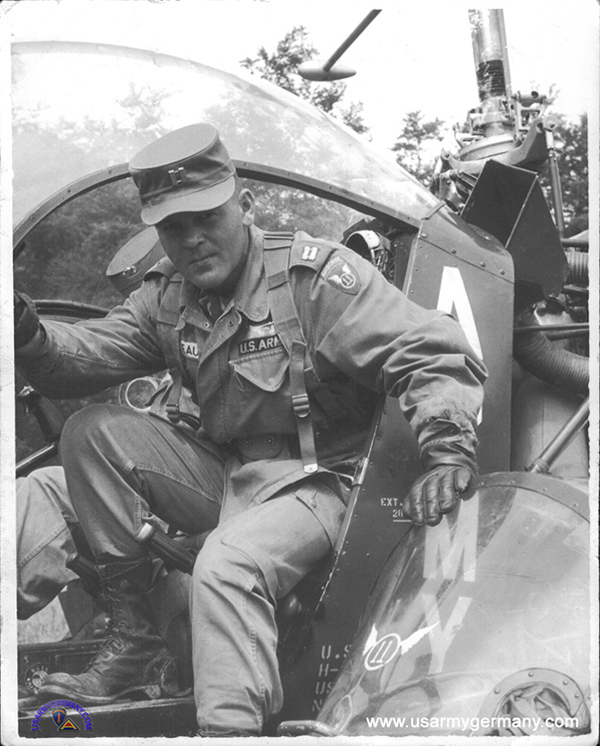 Capt Frank W. Nadeau exits an H-13 of the 11th Avn Co (Thomas Nadeau) |
|||||||||||||||||||||||||||||||||||||||||||||||||||||||||||||||||||||||||||||||||||||||
| (Source: Thomas Nadeau, son of the late Col Fran W. Nadeau) | |||||||||||||||||||||||||||||||||||||||||||||||||||||||||||||||||||||||||||||||||||||||
I was reading your website and noticed the part of the 11th Avn Co. My father was Capt. (later Col.) Frank W. Nadeau Jr. and we were at Munich from 1956 through 1958 and he was in the 11th Avn Co.
We had joined the 11th Airborne Division in 1955 at Fort Campbell, KY right after my father had graduated flight school. In Jan. 1956 we deployed with the 11th Abn Div and crossed the Atlantic on the USNS Gen. Maurice Rose and we lived at Warner Kaserne (dependent housing area). I had my 5th birthday on the crossing. Being a very young Army Brat at the time I do not recall much but remembered visiting the airfield several times. I do not recall what position my father had in the unit. I remember something about my dad being the USAREUR Aviator of the Year in 1956 (?). I don't remember where the airfield was but I remember OH-13s, L-19s and L-20 Beavers but nothing larger stationed there. I did see some C-119s land once. That is when I got my first helicopter ride. My dad put my older brother and me in one seat and then we went around scaring sheep off of the runway so the C-119s could land. If he had done that now days he probably would have been court martialed. We had a chaplain, Father Crownin (spelling?) who used to jump with the pathfinders out of dad's Beaver. We went to school at Perlacher Forrest which was on the south side of Munich. Our bus took us through downtown Munich and past McGraw Kaserne. Dad retired in 1979 and passed on in 2004. |
|||||||||||||||||||||||||||||||||||||||||||||||||||||||||||||||||||||||||||||||||||||||
Related Links: Paratroopers of the 50s - web site covers airborne units including the 11th Airborne Division in Germany in the late 1950s The Search for Atomic Age Division - Chapter X of Maneuver and Firepower, an Army Lineage Series historical manuscript. This manuscript is on-line at the US Army Center of Military History web site. |
|||||||||||||||||||||||||||||||||||||||||||||||||||||||||||||||||||||||||||||||||||||||
